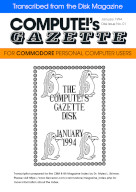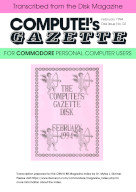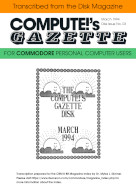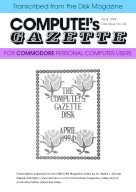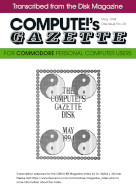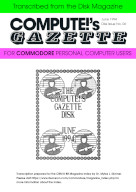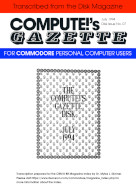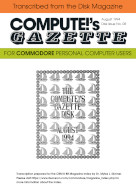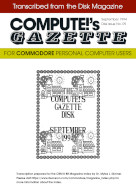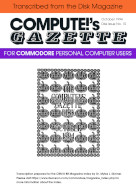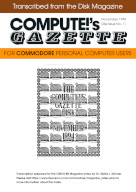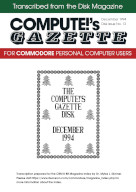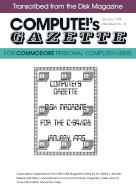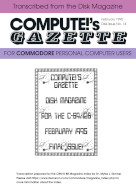New Printable Gazette Disk PDFs
Typeset by Dr. Myles L. Skinner
Let's start with a bit of history.
COMPUTE!'s Gazette was a magazine for Commodore enthusiasts that started in July 1983 as an offshoot of the home-computer-hobbyist magazine COMPUTE!—its focus was the VIC-20 and the new Commodore 64. Coverage grew to include the 128 and the VIC-20 material was slowly phased out over time. (The magazine kind of skipped past the Plus/4 and 16.) As the 8-bit market got smaller, the magazine got thinner, and the last stand-alone issue was published in June 1990. From October 1990 to December 1993, the Gazette lived on as a "special section" inside the parent magazine, which had rebranded as COMPUTE, losing the silly affectation of the '!' in its title. Starting in 1994, the Gazette disappeared from print entirely, and re-emerged as a disk-only magazine, with each issue published as a double-sided Commodore 1541-formatted floppy disk. For years, there had been a Gazette Disk that included programs from the magazine (plus a few bonuses), but starting in 1994, the disk became the actual magazine, housing the articles that would have appeared in the print edition.
In 1994, I knew the Gazette Disk was out there, but I never saw the disk itself while it was still "in print". Without access to pirated copies, I would never have read any Gazette Disk articles. I know I wasn't the only one in this situation, either. The classified ads on the disk promised to "reach more than 4000 Commodore 64 and 128 owners and users" so I think it's fair to assume that the disk's circulation was quite small. It seems that a lot of people never saw the Gazette Disk.
I used to buy COMPUTE (without the '!') on the newsstand in the early nineties because in Canada, the newsstand edition still had the "Special Gazette Section" inside, so I had read most of those. I'd also read most of the stand-alone issues of COMPUTE!'s Gazette because our local library had a subscription, and over time I picked up additional issues second hand. I've since acquired ALL the Gazettes, and, yes, I have read them all.
But I'd never read the disk magazine. When I finally got the disk images, I tried them out in the Vice emulator, but found the disk interface a bit clunky and never really read more than a handful of articles. I had no idea what was actually on those disks.
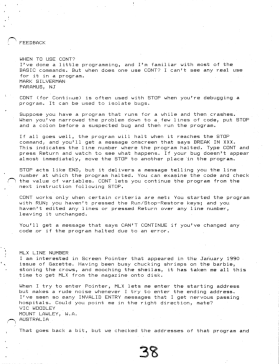
Enlarged Image
Historic Printouts
There's a set of Gazette Disk printouts prepared by Chris Ryan that have been kicking around the internet for many years. In the masthead Chris prepared for the final issue, he indicates that he made the printout in July of 1995, so I think it's safe to assume that all the printouts were prepared at around that time. Chris designed cover images in The Print Shop, arranged the articles in a sequence, prepared tables of contents, and then printed everything on a Panasonic KX-P1180 9-pin dot-matrix printer. I have no idea how scans of these printouts ended up online but I'm grateful for their existence.
The bulk of the pages were printed in the Panasonic's draft mode which produced a typeface that was functional but not especially easy on the eyes. The printouts themselves appear to have gone through generations of photocopying and low-resolution scanning. At one point, the pages had been punched to fit a 3-ring binder, leaving circular marks behind as scanning artefacts in the margins, and the page numbers are mostly scrawled in by hand. I tried running the printouts through OCR and the results were comically bad ("Welcome ta the new, improved Gazette Disk. I'm sure that these af you whe already subscribe ta Gazette Disk will notice the changes that have taken place within the past menth. We've added a number of features ta the disk..."), so it was clear that the computer was having even more trouble reading these texts than I was. I wanted to make these magazines accessible, so I decided that I should prepare a new, clean set of PDFs for modern readers.
As luck would have it, when I decided to start working on the Gazette Disks, I was
travelling, and staying in a location with no internet connection. I was stuck working without
documentation or any of the modern development tools I'd use if I were at home. Not only that,
it had been a long time since I'd written anything non-trivial in BASIC. Here's a fun challenge:
without looking anything up, write a quick BASIC program to stream a sequential file from a 1541
disk to the screen on the Commodore 64. If you can do that, your memory is better than mine. I
could remember fundamental steps (open the file for reading, loop through with GET#,
and so on) but the exact syntax of a disk command like M-R (or was that ,M,R?)
was not something that I could easily remember.
I could have waited to start work until I had returned to an internet-friendly locale, but
where's the fun in that? I took a quick inventory of my assets. I had the Vice emulator, all of
the Gazette Disk .d64 images, and a PDF of every North American Commodore-centric
magazine ever published. Aha! This I could work with. It didn't take long to find enough code
examples to steal and within a few minutes I had a program that would read a file one byte at a time,
run each byte through CHR$(), and print the results to the screen. Working in
this way reminded me a lot of programming the 64 in the early days: knowing the end result but
not quite knowing how to get there, and bodging something together in an improvisatory fashion.
The end result wasn't pretty but it would do the job.
I ran my new program, told it to open the first "D'Iversions" column, and watched with disappointment as my screen filled with mostly unprintable garbage. My concern at that point was that the text was compressed in some way, so to try and crack the compression, I modified my program to print out byte values. The results showed a lot of numbers lower than 32—unprintable as either ASCII or PETSCII, but valid as screen codes. In retrospect, I should have realized that the Gazette would have stored its text files in the format of their own in-house word processor SpeedScript, a program that handled its text data as Commodore screen codes instead of PETSCII.
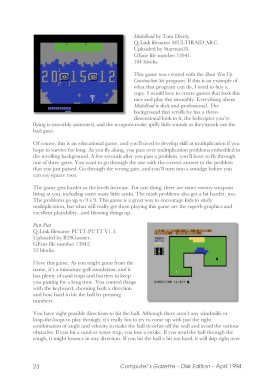
Enlarged Image
A Little Light Reading...And Publishing
I added pagination to turn my somewhat messy BASIC program into a simple version of UNIX's
more command. My little program made for a more comfortable reading experience than
the Gazette Disk's built-in text reader, but what I really needed was a way to extract
the text off the disks so that I could import the contents into Microsoft Word. By the
time I'd gotten this far, I had internet again, so I grabbed Style's DirMaster to decompose
the .d64 images into their component .prg files, and wrote a Ruby script
to convert screen codes to ASCII. From there, importing into Microsoft Word and cleaning up
the formatting was a simple, if tedious process.
I wanted to give my new PDFs covers, so I grabbed the banner from an old Gazette scan, did a little font research, and came up with a cover layout inspired by the magazines that were published in 1983. To honour the historical significance of Chris Ryan's work, I embedded his cover images on my covers. Inside each issue, I added screenshots of the ads and some of the programs included on disk. I also restored the masthead for the disks that omitted it so that the proper people could have credit for their work.
Setting the Gazette Disks in a modern word processor allowed me to add a bunch of publishing finesses: page numbers, footers, section headers, and even colourful screenshots that would not have been possible on the original disks. I didn't use a magazine-style layout where the text is laid out in columns. A good magazine will make liberal use of images and other layout elements like captions, kickers, and pull quotes to create visual interest. That kind of page design requires a lot more effort than I was willing to invest, so my Gazette PDFs end up looking more like collections of essays than glossy magazines—a rather stodgy way to present this material, but it does fulfill my goal of making the magazine contents accessible for modern readers.
Typesetting all 14 Gazette Disks took a while—about six weeks—but I enjoyed having an excuse to familiarize myself with their contents. I felt a bit like I was publishing these magazines myself back in the nineties—a lot of work but also a real nostalgia trip. Now that it's over, I kind of miss my pretend publishing gig, but I don't think I want to go through all this effort a second time. Sorry, Fender. Somebody else will have to print out the 241 issues of Loadstar.
Links
Archive of the new Gazette Disk transcriptions.
Archive of scans of Chris Ryan's original printouts.

